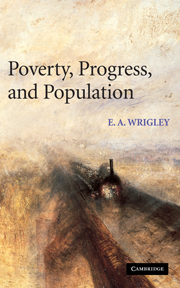Book contents
- Frontmatter
- Contents
- List of figures
- List of tables
- Acknowledgements
- Introduction
- PART I The wellsprings of growth
- PART II Town and country
- PART III The numbers game
- 12 Explaining the rise in marital fertility in England in the ‘long’ eighteenth century
- 13 No death without birth: the implications of English mortality in the early modern period
- 14 The effect of migration on the estimation of marriage age in family reconstitution studies
- 15 Demographic retrospective
- Bibliography
- Index
12 - Explaining the rise in marital fertility in England in the ‘long’ eighteenth century
Published online by Cambridge University Press: 23 December 2009
- Frontmatter
- Contents
- List of figures
- List of tables
- Acknowledgements
- Introduction
- PART I The wellsprings of growth
- PART II Town and country
- PART III The numbers game
- 12 Explaining the rise in marital fertility in England in the ‘long’ eighteenth century
- 13 No death without birth: the implications of English mortality in the early modern period
- 14 The effect of migration on the estimation of marriage age in family reconstitution studies
- 15 Demographic retrospective
- Bibliography
- Index
Summary
The two most effective ways of converting parish register data into estimates of fertility, mortality, and nuptiality in the past are generalised inverse projection and family reconstitution. In general, they produce reassuringly similar results for England in the early modern period. An earlier version of inverse projection, using aggregative tabulations from 404 parishes, was employed to generate the demographic estimates presented in the Population history of England, while, 16 years later, data from 26 parish reconstitutions formed the basis for the findings published in English population history from family reconstitution. The more refined measures produced by family reconstitution have enabled some of the input parameters used in inverse projection to be specified more accurately, and this in turn has led to minor modifications in the results obtained from the aggregative data, but, whether the original or the modified parameters are used, comparison of the output from the two methods suggests that both yield the same ‘big picture’.
Nevertheless, reconstitution has brought to light many previously unknown or obscure features of English population history, some of which are simultaneously illuminating and puzzling: illuminating because they enforce a revision of the received wisdom; puzzling because, although the existence of an unexpected pattern can be demonstrated, its explanation is unclear. The bulk of this essay is devoted to a possible explanation of one of the new findings of reconstitution, the rise in marital fertility which took place during the eighteenth century, for which no satisfactory explanation was offered in English population history. In a concluding section, the possible links between economic circumstances and population growth are discussed.
- Type
- Chapter
- Information
- Poverty, Progress, and Population , pp. 317 - 350Publisher: Cambridge University PressPrint publication year: 2004
- 3
- Cited by



